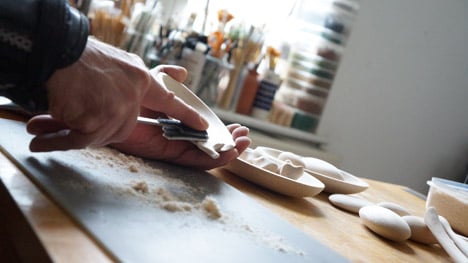Happaratus "power glove" carves objects with its fingertips
Graduate shows 2015: Royal College of Art graduate Morten Grønning Nielsen has designed a glove that can be used to sculpt hard materials like stone and wood by hand (+ slideshow).

Grønning Nielsen, who is graduating from the RCA's Innovation Design Engineering course this year, created the Happaratus "power glove" to extend the capabilities of the hand as a sculpting tool.

The tips of the glove's thumb, index and middle fingers are each mounted with two abrasive pads.

Powered by a hydraulic motor, these pads oscillate in opposite directions to carve away sections of material as the fingers caress it.
The interchangeable pads can be made in various shapes and different materials depending on the surface they are working on.

"You can make as many different bits as you want," Grønning Nielsen told Dezeen. "I could have some that are really strong and aggressive for stone carving for example, or others that can be used for detailed furniture restoration."
"It's really flexible, so you can get into all corners," he added.

The movements are powered by a motor mounted on the back of the hand, connected to a gearbox closer to the fingers. A small knob on the side of the box can be turned to control the oscillation speed of the pads, which are each linked to the motor by a wire.

To demonstrate how the tool could be used, Grønning Nielsen gave prototype versions of Happaratus to three artisans that work with wood, stone and plaster.

"What they have in common is that they need to have a really agile, manoeuvrable tool that they don't have at the moment," said the designer.
For example, sculptor David Neat – who works with balsa wood – used the device to shape a series of smooth objects including a set of small bowls.

"By user-testing the conceptual machines, it was confirmed that human proprioception and haptic feedback enables a user to sculpt extremely accurately and create highly complex geometries in a seamless workflow," said Grønning Nielsen, who also created a wooden speaker stand and a concrete lampshade with the tool himself.

Grønning Nielsen recently filed a patent for the design, which is on display at the Kensington campus as part of this year's Show RCA graduate exhibition – open to the public from 25 June until 5 July 2015.
The RCA – which was recently named the world's top design school – held it's annual catwalk show for 2015 fashion graduates earlier this month. A number of staff have recently stepped down from senior positions at the school, including the head of the interior design programme, and the heads of the textiles and design interactions departments.

A variety of digital tools designed specifically for the creative industries have emerged recently. Last year, musician Imogen Heap unveiled a glove created to enable musicians to manipulate sounds using hand gestures – our movie demonstrating the project won a 2015 Webby Award.

Belgian studio Unfold also developed a set of instruments that measure physical objects and transfer the dimensions to a digital model in real time on screen.